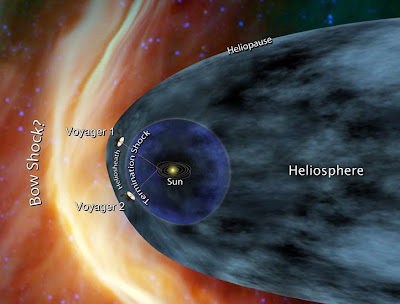Scientists analyzing recent data from NASA's Voyager and Cassini spacecraft have calculated that Voyager 1 could cross over into the frontier of interstellar space at any time and much earlier than previously thought. The findings are detailed in this week's issue of the journal Nature.
Data from Voyager's low-energy charged particle instrument, first reported in December 2010, have indicated that the outward speed of the charged particles streaming from the sun has slowed to zero. The stagnation of this solar wind has continued through at least February 2011, marking a thick, previously unpredicted "transition zone" at the edge of our solar system.
"There is one time we are going to cross that frontier, and this is the first sign it is upon us," said Tom Krimigis, prinicipal investigator for Voyager's low-energy charged particle instrument and Cassini's magnetospheric imaging instrument, based at the Johns Hopkins University Applied Physics Laboratory in Laurel, Md.

No comments:
Post a Comment